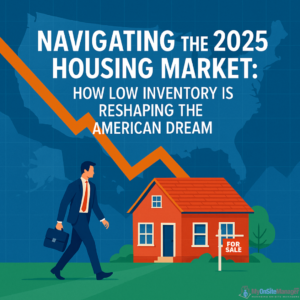As we move deeper into 2025, the housing market continues to face a critical challenge that is shaping everything from home prices to buyer behaviors: inventory shortages. The lack of available homes is driving some of the most defining trends of today’s real estate environment — and it’s prompting major shifts in where and how Americans choose to buy.
The Inventory Crisis: Not Enough Homes to Go Around
The root of the issue? There simply aren’t enough homes on the market.
Although homebuilders are trying to close the gap with new construction, much of the inventory remains out of reach for first-time or middle-income buyers. Many existing homeowners are also staying put, locked into historically low mortgage rates they secured in previous years — and understandably hesitant to sell in today’s 6.5%–7% mortgage rate environment.
As a result, the inventory of existing homes remains extremely tight, with fewer listings and fierce competition among buyers.
New Construction on the Rise — But Is It Enough?
With traditional resale inventory stagnant, newly built homes are picking up the slack. Builders are racing to meet demand, especially in suburban areas and Sun Belt states like Texas, Florida, and Arizona. However, many of these new homes are smaller, more condensed, and located farther from urban centers — a shift in style and geography meant to keep prices somewhat manageable.
Despite those efforts, affordability remains a challenge. Builders face rising labor and material costs, supply chain delays, and limited land availability — all of which trickle down to the consumer.
Buyers Face Tough Choices
For today’s buyers, navigating the market feels like a balancing act:
-
Do you wait and hope for lower rates or more inventory later in the year?
-
Do you buy now and lock in a price before values rise further?
-
Or do you shift your expectations — smaller homes, different locations, or new builds — to get in the door?
Buyers are increasingly making concessions. According to recent data, nearly one in five homes sold in Q1 2025 involved some form of price cut or seller concession, including mortgage rate buydowns or assistance with closing costs.
What Could Shift Later in 2025?
Experts predict that the second half of 2025 may bring modest improvements, especially if the Federal Reserve eases interest rates. That could unlock more listings from current homeowners and improve affordability through lower borrowing costs.
However, until then, the market remains tight — and those looking to buy must be agile, well-informed, and financially prepared.
Final Thoughts: How to Navigate Today’s Market
Whether you’re a buyer, seller, or simply watching from the sidelines, the 2025 housing market demands a strategic approach:
Buyers: Get pre-approved, work closely with agents, and consider new builds or alternative locations.
Sellers: You still have leverage in most markets, but be open to concessions or repairs.
Renters: Keep an eye on local trends — in many places, renting may still be more affordable in the short term.
The inventory crunch is likely to remain a defining feature of the housing landscape throughout 2025. Staying flexible, proactive, and educated will be key to navigating the challenges — and finding opportunity in a constrained market.
Read the full article here: CNET – Homes in Short Supply: How Inventory Will Shape the 2025 Housing Market

